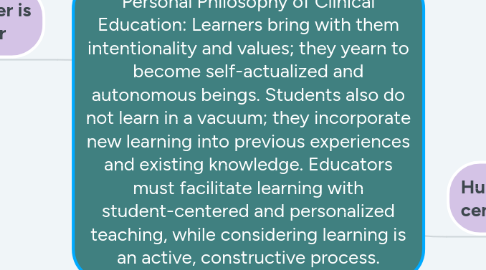
1. Personal Philosophy
2. Constructivism: The learner is an information constructor
2.1. Learning is an active, constructive process; the learner is an information constructor. New information is linked to prior knowledge, thus mental representations are subjective. Knowledge is constructed based on personal experiences and hypotheses of the environment; these hypotheses are continuously tested through social negotiation. The learner is not a tabula rasa, but brings past experiences and cultural factors to a situation.
2.2. Cognitive Apprenticeship: Six teaching methods enabling students to utilize cognitive and metacognitive strategies for "using, managing, and discovering knowledge."
2.2.1. Modeling: Experts demonstrate a task, while learners build a conceptual model of that task.
2.2.1.1. The preceptor demonstrates a head to toe physical assessment of a newborn, while the learner contemplates how they will perform the task in the future.
2.2.2. Coaching: The expert gives feedback and hints to the learner.
2.2.2.1. The learner demonstrates a newborn assessment, while the preceptor gives verbal cues.
2.2.3. Scaffolding: The process of supporting students in their learning. Support structures are developed. The preceptor may help with aspects the learner cannot yet perform.
2.2.3.1. The preceptor assists as the learner performs an assessment of the newborn's hips. The preceptor places their hands over the learner's as they proceed, demonstrating the movements of the assessments.
2.2.4. Articulation: Component knowledge and skills are separated to learn them more effectively. Knowledge and thinking processes are verbalized or demonstrated.
2.2.4.1. The preceptor asks the learner questions about the newborn assessment, allowing the learner to refine and restate their learned knowledge and to form explicit conceptual models. The learner thinks aloud to articulate their thoughts while solving problems.
2.2.5. Reflection: The learner can look back and analyze their performance with a desire for understanding and improvement towards the behavior of an expert.
2.2.5.1. The learner writes a reflection of their newborn assessment, while examining their performance and comparing and contrasting with that of the preceptor.
2.2.6. Exploration: The learner is given room to solve problems themselves while using exploration strategies. The learner frames interesting problems within the domain for themselves and takes the initiative to solve these problems.
2.2.6.1. As the learner performs subsequent newborn assessments, the preceptor does not intervene with input or assistance, but allows the learner to proceed and problem solve independently.
3. Humanism: Learning is student centered and personalized
3.1. People act with intentionality and values. It is necessary to study the person as a whole, especially as an individual grows and develops over the lifespan. The study of self, motivation, and goals are areas of particular interest. A primary purpose of humanism is the development of self-actualized, autonomous people. Learning is student-centered and personalized. The educator is a facilitator. A cooperative, supportive environment focusing on affective and cognitive needs are key.
3.2. Experiential Learning (Kolb): Four stage cyclical theory combining experience, perception, cognition, and behavior. "Learning is the process whereby knowledge is created through the transformation on experience."
3.2.1. Concrete experience, "Do": The learner actively experiences an activity.
3.2.1.1. A day spent in the clinical setting, working with the preceptor.
3.2.2. Reflective observation "Observe": The learner consciously reflects back on that experience.
3.2.2.1. The learner writes a reflection of their day in the clinical setting.
3.2.3. Abstract conceptualization "Think": The learner attempts to conceptualize a theory or model of what is observed.
3.2.3.1. The learner thinks about how to use what they have learned in future experiences.
3.2.4. Active experimentation "Plan": The learner is trying to plan how to test a model or theory or plan for a forthcoming experience.
3.2.4.1. The learner works with their cohort in a role-playing demonstration.

